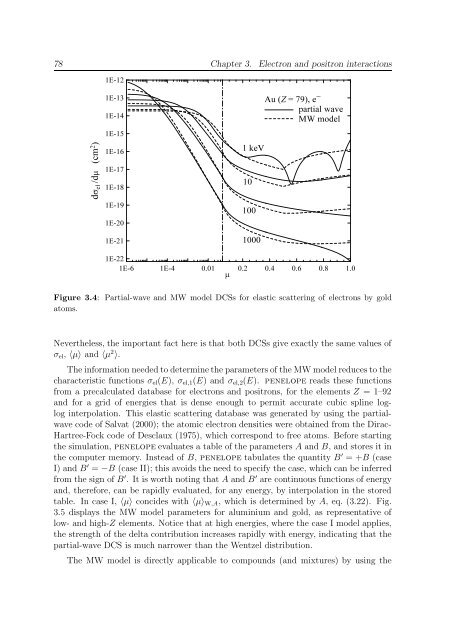PENELOPE 2003 - OECD Nuclear Energy Agency
PENELOPE 2003 - OECD Nuclear Energy Agency
PENELOPE 2003 - OECD Nuclear Energy Agency
You also want an ePaper? Increase the reach of your titles
YUMPU automatically turns print PDFs into web optimized ePapers that Google loves.
78 Chapter 3. Electron and positron interactions<br />
1 E - 1 2<br />
1 E - 1 3<br />
1 E - 1 4<br />
A u ( Z = 7 9 ) , e −<br />
p a r t i a l w a v e<br />
M W m o d el<br />
1 E - 1 5<br />
dσ el<br />
/dµ (cm 2 )<br />
1 E - 1 6<br />
1 E - 1 7<br />
1 E - 1 8<br />
1 E - 1 9<br />
1 keV<br />
10<br />
10 0<br />
1 E - 20<br />
1 E - 21<br />
10 0 0<br />
1 E - 22<br />
1 E - 6 1 E - 5 1 E - 4 1 E - 3 0.01<br />
µ<br />
0.2 0.4 0.6 0.8 1 .0<br />
Figure 3.4: Partial-wave and MW model DCSs for elastic scattering of electrons by gold<br />
atoms.<br />
Nevertheless, the important fact here is that both DCSs give exactly the same values of<br />
σ el , 〈µ〉 and 〈µ 2 〉.<br />
The information needed to determine the parameters of the MW model reduces to the<br />
characteristic functions σ el (E), σ el,1 (E) and σ el,2 (E). penelope reads these functions<br />
from a precalculated database for electrons and positrons, for the elements Z = 1–92<br />
and for a grid of energies that is dense enough to permit accurate cubic spline loglog<br />
interpolation. This elastic scattering database was generated by using the partialwave<br />
code of Salvat (2000); the atomic electron densities were obtained from the Dirac-<br />
Hartree-Fock code of Desclaux (1975), which correspond to free atoms. Before starting<br />
the simulation, penelope evaluates a table of the parameters A and B, and stores it in<br />
the computer memory. Instead of B, penelope tabulates the quantity B ′ = +B (case<br />
I) and B ′ = −B (case II); this avoids the need to specify the case, which can be inferred<br />
from the sign of B ′ . It is worth noting that A and B ′ are continuous functions of energy<br />
and, therefore, can be rapidly evaluated, for any energy, by interpolation in the stored<br />
table. In case I, 〈µ〉 concides with 〈µ〉 W,A , which is determined by A, eq. (3.22). Fig.<br />
3.5 displays the MW model parameters for aluminium and gold, as representative of<br />
low- and high-Z elements. Notice that at high energies, where the case I model applies,<br />
the strength of the delta contribution increases rapidly with energy, indicating that the<br />
partial-wave DCS is much narrower than the Wentzel distribution.<br />
The MW model is directly applicable to compounds (and mixtures) by using the
















